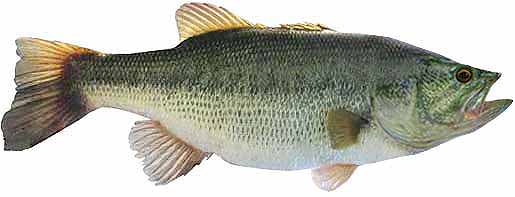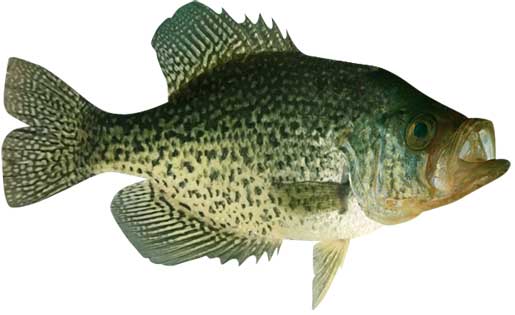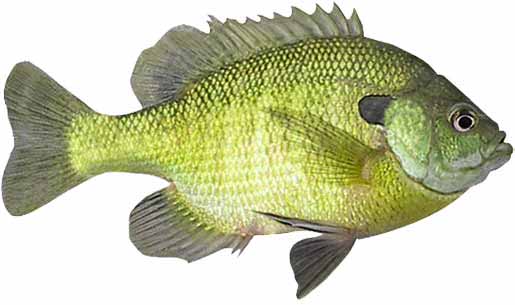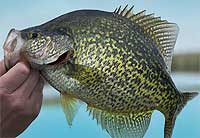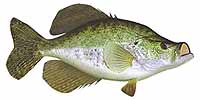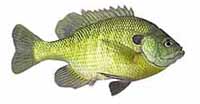Fishing Report For Lake Of Egypt, IL
By Rick Seaman
Last updated on .
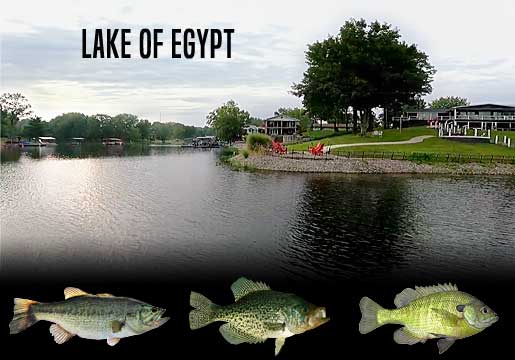
Fishing Reports
Popular Fish Species Lake Of Egypt, IL
Largemouth Bass
Current Report: Fair To Good
Historically, Lake Of Egypt has produced many largemouth bass in excess of 6 pounds. Recent reports indicate that while there are still many quality bass in the lake, there is a preponderance of bass in the 5 pound range. 6-pound bass are still caught, but not with the frequency of previous years. Most tournaments are won with about a 3-pound average per bass.
FALL. Now that Fall has arrived, bass here have moved shallow, following schools of baitfish into coves and shallow bays around 4 to 10 feet of water. Currently topwater, jerkbaits, crankbaits, and slow-rolled spinnerbaits are catching most of the bass. Later in Fall, as deeper water cools, bait and bass move out to ledges, channel edges, points and humps where flutter spoons, jigs and drop shots are often good choices in 10 to 15 feet of water.
WINTER. Winter will isolate largemouth around slightly deeper structure, flats, points and creek channels. They can be found from 10 to 30 feet deep. Here they hold, feeding less frequently, awaiting warmer water to return in Spring. Slow presentations are key to getting bites. On warmer days, especially during late afternoons, bass may move into 6 to 12 feet of water to feed.
SPRING. Once water temperatures rise into the low 60's, largemouth will move from deep wintering holes, to shallower water nearby spawning areas. Vibrating jigs, jerkbaits and spinnerbaits typically get bites just away from the shoreline. At this time they are feeding aggressively in about 5 to 12 feet of water, preparing for the spawn. Once water warms into the mid to high 60's, they will move into 2 to 4 feet of water, and create nests, then lay their eggs. Immediately afterwards, females move to deeper water and males remain to guard the eggs, and then the fry. After a couple weeks, the males also move to slightly deeper water. Deep-diving crankbaits, vibrating jigs, plastic worms and swimbaits are catching bass during this period.
SUMMER. Water temperatures will warm considerably in Summer. Bass will feed shallow, early and late in the day, where they will be caught in 5 to 10 feet of water. Topwater, square-bill crankbaits and spinnerbaits. Wacky-rigged stick worms always catch finicky bass when the bite is slow. Largemouth bass here feed on gizzard shad, threadfin shad, small sunfish and crawfish. During the hotter parts of the day, they are being caught on points, channel edges, and ledges 15 to 20 feet deep.
Black Crappie
Current Report: Good
Due to warmed water by the power-plant, crappie fishing is decent year round at Lake of Egypt.
FALL. Baitfish, which are moving into shallow flats, coves and bays, are drawing crappie into these areas. Nice crappie are being caught while feeding heavily, in preparation for the cold Winter. Anglers report that 5 to 15 feet of water is where most bites are coming. Minnows, hair jigs, and crappie jigs, are good options during this feeding marathon. Late fall starts the migration deeper, toward winter holding areas, for both crappie and baitfish. Small flutter spoons, fished in 15 to 20 feet of water, are a good option during this transition. Good results are coming around points, creek channels, and brush piles.
WINTER. Once the shallows start cooling rapidly, crappie will migrate to deeper holding areas, mostly off shore. At this time they are typically caught using a very slow presentation, in 12 to 25 feet of water. Most are caught around deep brush piles, creek channel bends, submerged timber, and main-lake structure. If they are suspending in open water, they often relate to some cover, or structure change, directly below them. During warming trends, especially warm afternoons, they are drawn into 8 to 15 feet of water to feed.
SPRING. Normally, Spring is the premiere time to be on the water as crappie move into shallow coves to spawn. However, locals report good crappie fishing as early as February from the Southern Illinois Power Plant, to Eagle Point. Docks, brush, wood and deep vegetation are a good place to cast small crappie jigs or live minnows. Many dock owners plant brush piles around their dock, which attract crappie. Crappie begin staging in 5 to 15 feet of water, just outside spawning bays and shallow flats. Spring is prime time to be on the water, as crappie have moved shallow to spawn. At that time, they are typically caught in 1 to 6 feet of water. Vegetation, docks, brush and wood are where most anglers catch crappie using small crappie jigs or live minnows. After the spawn, crappie typically move outside the spawning area and hold on cover close by, in 12 to 18 feet of water. Once they move deep, anglers report success using fish finders and forward facing sonar to locate schools of crappie, which tend to stack vertically around cover. Light tackle, with 4 lb to 8 lb line, is a popular choice. Later in Spring, focus on shallower flats around 5 to 15 feet deep.
SUMMER. Water temperatures get quite warm, and crappie fishing is usually pretty good. They feed in 8 to 15 feet of water early and late in the day, until the hot Summer sun causes them to retreat to depths of 15 to 30 feet. Also, a few have embedded in the shade of slightly shallower vegetation. This is a good time to focus around brush piles, standing timber, deep lay downs, bridge pilings and deeper docks. Anglers are also locating schools of crappie hanging over deep structure and around creek channel edges, using fish-finder electronics.
Bluegill
Current Report: Good
Having warm water year round increases the growing time for fish, including bluegill which are abundant in the reservoir. Here, they grow big and fat and are fun to catch. Bluegill are always looking for food, and will hang around cover in fertile water. Short pieces of good ole nightcrawlers are always a good bait for these sunfish.
FALL. Cooling, Fall weather drops the water temperature in the shallows and is luring bluegill into the shallows along the shoreline. Steeper banks, and shallow, weedy areas with drop-offs are drawing bluegill into 6 to 10 feet of water. Later in Fall, as the shallows get colder, bluegill will move slightly deeper in the same areas.
WINTER. Cooling shallows have driven the bluegill back to deeper cover, in water ranging from 10 to 18 feet, near brush piles or deeper structure. In areas with no cover, anglers typically find them around sharp drops, into even deeper water.
SPRING. In early Spring, bluegill migrate from winter holding areas toward the shoreline areas, and are typically caught around 2 to 6 feet deep. As the water warms to the mid 70's they will begin the spawning ritual, building nests in 1 to 3 feet of water. Many of the bigger bluegill prefer to spawn a bit deeper, depending on water clarity. After the spawn, bluegill drop slightly deeper again. Small spinners and swimbaits, or jigs tipped with small pieces of nightcrawlers are good choices for catching a lot of bluegill in spring. A hook, line, weight and bobber, with small pieces of worms, also catches lots of bluegill.
SUMMER. Following the spawn, most of the bigger bluegill migrate to deeper water, around 8 to 10 feet deep. They prefer rocky or weedy areas, often hanging out on steep, rocky banks where they can move up and down to feed without having to travel a great distance. Small spoons, underspins, and mini-crankbaits are catching some of the bigger bluegill. Earthworms are also catching good numbers.
Fishing Video
Fish species to fish for...
Guide to fishing for largemouth bass, black crappie, white crappie and bluegill at Lake Of Egypt in Illinois.
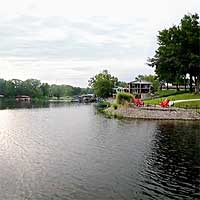 Lake Of Egypt is a 2,300-acre lake with over 90 miles of shoreline. Shoreline fishing and portage of canoes or kayaks, is available at Buck Ridge Campground and several other areas as well. The bass grow big in Lake of Egypt, making it a popular destination for bass tournaments. Bluegill are abundant in the lake. Crappie are a highly sought species, and can be found in good numbers.
Lake Of Egypt is a 2,300-acre lake with over 90 miles of shoreline. Shoreline fishing and portage of canoes or kayaks, is available at Buck Ridge Campground and several other areas as well. The bass grow big in Lake of Egypt, making it a popular destination for bass tournaments. Bluegill are abundant in the lake. Crappie are a highly sought species, and can be found in good numbers.
Primary fish species to catch
Click images for fishing tips and details about each species.
Today's Weather & Forecast
Fishing Boat Rentals
Click here for fishing boat rentals.
Public Boat Launch Ramps & Landings
Click here for boat ramps.
Marinas
Click here for marinas.
Fishing License
Click here for a Illinois Fishing License.
Map - Fishing & Access
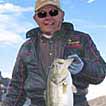 Rick Seaman is a fishing enthusiast with over five decades of fishing experience, a retired tournament fisherman, author of numerous published articles on fishing, and co-author of the book "Bass Fishing - It's not WHAT you throw, It's WHERE you throw it".
Rick Seaman is a fishing enthusiast with over five decades of fishing experience, a retired tournament fisherman, author of numerous published articles on fishing, and co-author of the book "Bass Fishing - It's not WHAT you throw, It's WHERE you throw it".
 Contact Information
Contact Information
Mack's Lake of Egypt Marina
12024 Laguna Dr
Marion, IL 62959
618 964-1821
Fishing lakes in each state
102025
Lake Of Egypt, Illinois Report
ILLINOIS


Information about fishing lakes in Illinois
Lake Of Egypt offers bass, bluegill and crappie fishing in southern Illinois.


